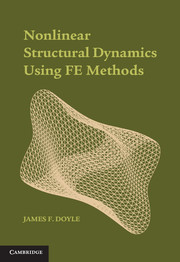Book contents
3 - Modeling Elastic Structures
from PART I - MECHANICS AND MODELS
Published online by Cambridge University Press: 05 October 2014
Summary
Real structures, of course, are not just a collection of springs and concentrated masses as modeled in the two preceding chapters; they are assembled systems comprising members such as panels and beams that have continuously distributed properties of mass and elasticity. Our analytical mechanics formulation is now extended to include these systems by replacing them with a discretized representation. The process of replacing a continuous body with a discrete representation is inherently approximate, but the principle of virtual work in conjunction with the Ritz method allows us to do this in a rational way. Furthermore, the approach adopted has the built-in capability to achieve any desirable level of accuracy. The ultimate computer implementation of the approach is in the form of the finite-element (FE) method.
The finite-element method is covered extensively in references such as 5, 18, 22, 30, 96, and 99 so only the aspects most relevant to the dynamics of structures are covered here. The principal structural types covered are frames and solids; structures such as plates and shells are rendered as special cases of three dimensional (3D) solids. The frame is modeled as having the separate actions of axial extension, bending, and torsion, and a FE model is developed for each of these. The dynamics of a general solid is modeled with the very versatile Hex20 element.
- Type
- Chapter
- Information
- Nonlinear Structural Dynamics Using FE Methods , pp. 92 - 205Publisher: Cambridge University PressPrint publication year: 2014

